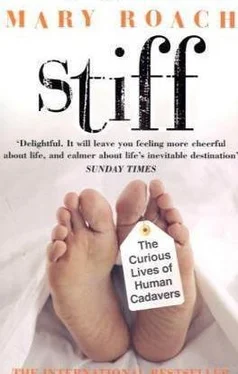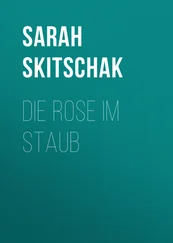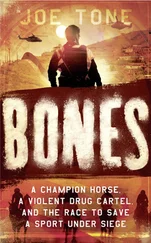In the weeks that followed, Barbet went through twelve more arms in a quest to find a suitable point in the human wrist through which to hammer a 1/3-inch nail. This was not a good time for vigorous men with minor hand injuries to visit the offices of Dr. Pierre Barbet.
Eventually, Barbet’s busy hammer made its way to what he believed was the true site of the nail’s passage: Destot’s space, a pea-sized gap between the two rows of the bones of the wrist. “In each case,” he wrote, “the point took up its own direction and seemed to be slipping along the walls of a funnel and then to find its way spontaneously into the space which was awaiting it.” It was as though divine intervention applied to nail trajectories as well. “And this spot,” Barbet continued triumphantly, “is precisely where the shroud shows us the mark of the nail, a spot of which no forger would have had any idea….”
And then along came Frederick Zugibe.
Zugibe is a gruff, overworked medical examiner for Rockland County, New York, who spends his spare time researching the Crucifixion and “Barbet-bashing” at what he calls “Shroudie conferences” around the world. He’ll always make time to talk to you if you call, but it becomes quickly clear in the course of the conversation that spare time is something Zugibe has very little of. He’ll be halfway through an explanation of the formula used to determine the pull of the body on each of Christ’s hands when his voice will wander away from the telephone for a minute, and then he’ll come back and say, “Excuse me. A nine-year-old body. Father beat her to death. Where were we?”
Zugibe is not on a mission to prove the authenticity of the Shroud of Turin—as, I suspect, Barbet was. He became interested in the science of crucifixion fifty years ago, as a biology student, when someone gave him a paper to read about the medical aspects of the Crucifixion. The physiological information in the paper struck him as inaccurate. “So I researched it out, wrote a term paper, got interested.” The Shroud of Turin interested him only in that it might, were it for real, provide a great deal of information about the physiology of crucifixion. “Then I came across Barbet. I thought, Gee, this is exciting. Must be a real smart guy—double blood flow and all that.” Zugibe began doing research of his own.
One by one, Barbet’s theories fell apart.
Like Barbet, Zugibe constructed a cross, which has stood—with the exception of several days during 2001 when it was out for repairs (warped stipes)—in his garage in suburban New York for some forty years. Rather than crucifying corpses, Barbet uses live volunteers, hundreds in all. For his first study, he recruited just shy of one hundred volunteers from a local religious group, the Third Order of St. Francis.
How much do you have to pay a research subject to be crucified?
Nothing. “They would have paid me,” says Zugibe. “Everyone wanted to go up and see what it felt like.” Granted, Zugibe was using leather straps, not nails. (Over the years, Zugibe has occasionally received calls from volunteers seeking the real deal. “Would you believe? A girl called me and wanted me to actually nail her. She’s with this group where they put plates in their face, they surgically alter their heads, they bifurcate their tongues and put those things through their penis.”)
The first thing Zugibe noticed when he began putting people up on his cross was that none of them were having trouble breathing, even when they stayed up there for forty-five minutes. (He’d been skeptical about Barbet’s suffocation theory and dismissive of the reference to torture victims because those men’s hands were directly over their heads, not out to their sides.) Nor did Zugibe’s subjects spontaneously try to lift themselves up. In fact, when asked to do so, in a different experiment, they were unable to. “It is totally impossible to lift yourself up from that position, with the feet flush to the cross,” Zugibe asserts. Furthermore, he points out, the double blood flows were on the back of the hand, which was pressed against the cross. If Jesus had been pushing himself up and down, the blood oozing from the wound would have been smeared, not neatly split into two flows.
What, then, could have caused the famed double flow marks on the Shroud? Zugibe imagines its having happened after Jesus was taken down from the cross and washed. The washing disturbed the clotting and a small quantity of blood trickled out and split into two rivulets as it encountered the ulnar styloid protuberance, the bump that protrudes from the pinkie side of the wrist. Zugibe recalled having seen a flow of blood just like this on a gunshot victim in his lab. He tested his theory by washing the dried blood from the wound of a recently arrived corpse in his lab to see if a small quantity of blood might leak out. “Within a few minutes,” he writes in an article published in the Shroudie journal Sindon , “a small rivulet of blood appeared.”
Zugibe then noticed that Barbet had made an anatomical blunder regarding Destot’s space, which is not, as Barbet crowed in his book, “precisely where the shroud shows us the mark of the nail.” The wound on the back of the hand on the Shroud of Turin appears on the thumb side of the wrist, and any anatomy textbook will confirm that Destot’s space is on the pinkie side of the wrist, where Barbet indeed sank his nails into his cadaver wrists.
Zugibe’s theory holds that the nail went in through Jesus’ palm at an angle and came out the back side at the wrist. He has his own brand of cadaveric evidence: photographs taken forty-four years ago of a murder victim that showed up in his lab. “She’d been brutally stabbed over her whole body,” Zugibe recalls. “I found a defense wound where she had raised her hand in an attempt to protect her face from the vicious onslaught.” Though the entry wound was in the palm, the knife had apparently traveled at an angle, coming out the back of the wrist on the thumb side. The pathway of the knife apparently offered little resistance: An X-ray showed no chipped bones.
There is a photograph of Zugibe and one of his volunteers in the aforementioned Sindon article. Zugibe is dressed in a knee-length white lab coat and is shown adjusting one of the vital sign leads affixed to the man’s chest. The cross reaches almost to the ceiling, towering over Zugibe and his bank of medical monitors. The volunteer is naked except for a pair of gym shorts and a hearty mustache. He wears the unconcerned, mildly zoned-out expression of a person waiting at a bus stop. Neither man appears to have been self-conscious about being photographed this way. I think that when you get yourself down deep into a project like this, you lose sight of how odd you must appear to the rest of the world.
No doubt Pierre Barbet saw nothing strange or wrong in using cadavers meant for the teaching of anatomy as subjects in a simulated crucifixion to prove to doubters that the miraculous Shroud of Turin was for real. “It is indeed essential,” he wrote in the introduction to A Doctor at Calvary , “that we, who are doctors, anatomists, and physiologists, that we who know, should proclaim abroad the terrible truth that our poor science should no longer be used merely to alleviate the pains of our brothers, but should fulfill a greater office, that of enlightening them.”
To my mind there is no “greater office” than that of “alleviating the pains of our brothers”—certainly not the office of religious propaganda. Some people, as we’re about to see, manage to alleviate their brothers’ pains and sufferings while utterly dead. If there were ever a cadaver eligible for sainthood, it would not be our Spalding Gray upon the cross, it would be these guys: the brain-dead, beating-heart organ donors that come and go in our hospitals every day.
Читать дальше












